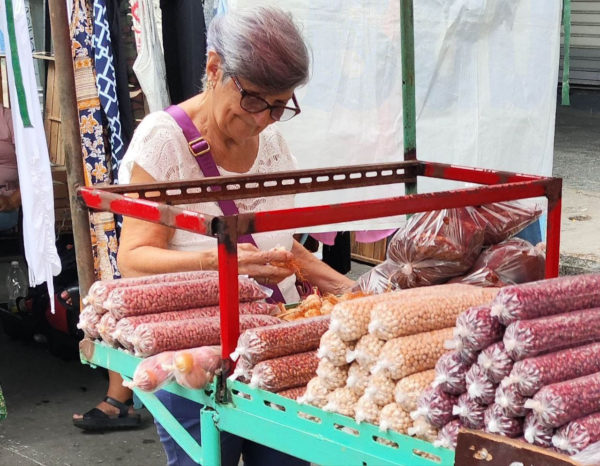Garbanzo Beans Have Become a Luxury Food in Cuba

This week a pound of chickpeas costs 700 pesos ($2.20 USD). In September of last year, the price was 450.
By Natalia Lopez Moya (14ymedio)
HAVANA TIMES – They share the market stall with black beans and green beans but no one would put them in the same category much less combine them. Of all the legumes consumed in Cuba, chickpeas — also known as garbanzo beans — are the most prestigious as well as the most demanding when it comes to preparation. A red line separates them from dried peas and lentils, one that clearly indicates that this is a luxury few can afford.
Never eaten just by themselves, in Cuba chickpeas are prepared mainly as part of a stew to which a long list of other ingredients must be added, each one more expensive than the last: chorizo, blood sausage, bacon, onion, garlic, chili, tomato sauce, cumin and some potato or pumpkin. The list of additional ingredients just happens to include almost all of the most expensive items on the market.
The first financial obstacle is getting hold of the wrinkled, pale yellow bean itself. Its size, the thickness of the shell, how much water it absorbs during the soaking process and its final texture are all indications of quality. The better the flavor, the more desirable. The better the breed, the tighter the supply. The higher the pedigree, the higher the price. Buying a package of chickpeas in Cuba has become an act of exhibitionism, a form of showing off, like saying, “Check me out. I can afford to eat a good ’garbanzada’.”
It is one of those dishes that Cubans associate with Spanish grandparents, who were not not able to serve it back in the 1970s and ’80s when chickpeas virtually disappeared from store shelves. The memory of their flavor and texture became almost mythological. It was story told round the table to keep hope alive and to make their grandchildren’s mouths water.
At the produce market on 19th and B streets in Havana’s Vedado district — a place with a reputation for having the widest array of products and the highest prices in the entire Cuban capital — a pound of garbanzos was selling for 700 pesos this week. Some of them were large, clean and and well packaged. The chorizos and smoked ham hanging a few yards away could help complete the dowry necessary for the cooking ceremony.
A year ago, in September 2023, when the price hit 450 pesos a pound in the same market, customers raised their eyebrows, slapped their foreheads and swore off buying them.
Twelve months later, few customers can bring themselves to buy even one or two packages. Those who do quickly pay for the vendor and hurriedly put their purchase in a shopping bag. Showing off your chickpeas is now like wearing a gold chain around your neck or a Swiss watch around your wrist.
“My mother died in 1991 at the height of the Special Period. Her last wish was to have a plate of chickpeas with chorizo. I was never able to give that to her,” recalls Margarita, the 67-year-old descendant of Spanish immigrant parents who met in Havana. Her mother came over to work at an uncle’s corner store and her father arrived on one of the many ships carrying migrants with dreams of making it rich in Cuba.
“My mother always used to say that the best garbanzo beans were grown in Spain, in her province, Extremadura. So when they were becoming scarce, there were a lot of problems because the ones you could buy here were of very poor quality — small, tough and without much flavor,” Margarita recalls. “When they opened the Mercado Libre Campesino (Free Peasants Market) in the 1980s, the first thing she did was to get all dressed up and head out to the Plaza de Cuatro Caminos like she was going to a wedding.”
Once the her mother got to the huge marketplace, now a hard-currency store, she went straight to the only stall selling chickpeas, her two children and six grandchildren in tow. There, before their eyes, were the coarse little balls that reminded her of her mother and grandmother, whom she never saw again after crossing the Atlantic.
“She bought a pound of chickpeas and I grabbed some chorizos. Once she ate the finished dish, she was sweating profusely. She said she was out of her mind, that all scarcity had damaged her stomach so much that she could no longer digest good food,” recalls Margarita. “That was the last of them. Then the Soviet Union collapsed, my mother died and we were never able to make the dish again. In those days, you couldn’t even find salt and we didn’t have gas to put the pot on to soften them up.”
Margarita’s mother has been dead for more than three decades. Chickpeas can now be found in Cuban markets. There are those grown on the island, which are less popular due to their small size and toughness, and others imported in packages with fancy names and colorful images. Both are still luxury items, one of those final requests that some elderly people still make, sending their children running to the market and draining the family coffers.
Translated by Translating Cuba.





